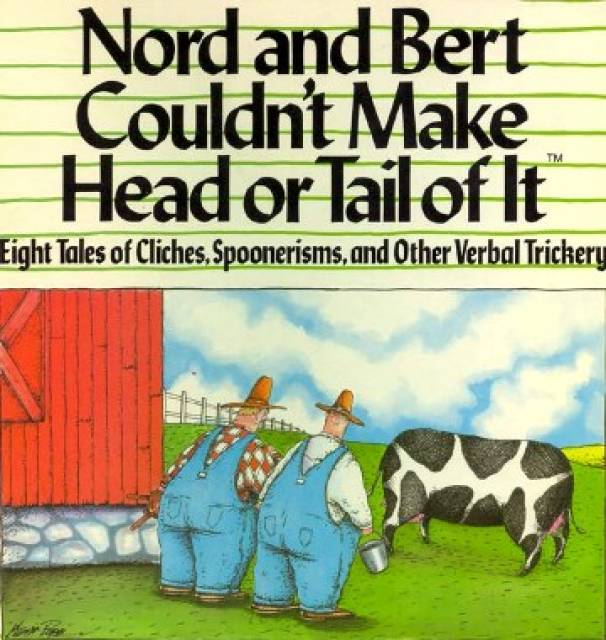Overview
Nord and Bert Couldn't Make Head or Tail of It (hereinafter referred to as Nord and Bert) was the 27th game released by interactive fiction pioneers Infocom.
Described by the company as "interactive short stories", Nord and Bert's wordplay-based gameplay marks it as unique in Infocom's catalog.
Development/Reception
The game designer/programmer (or as Infocom called it, "implementor", or "imp") for Nord and Bert was Jeff O'Neill. This was O'Neill's second, and final, game as an "imp". (His previous game was Ballyhoo).
Nord and Bert was released simultaneously with Plundered Hearts. It sold approximately 17,000 copies.
Story/Gameplay
Nord and Bert is divided into eight "chapters", all of which take place in the town of Punster. The first seven chapters can be played in any order. Popular consensus does find chapters 1-4 to be easier as a whole than chapters 5-7. All seven of the beginning chapters must be handled successfully in order to proceed to the eighth and final chapter (although they need not be completed in full.)
The chapters are:
- "The Shopping Bizarre": This chapter is based around homonyms (as in the title's "bizarre", which is pronounced similarly to "bazaar"). As the title implies, it takes place in a grocery store.
- "Playing Jacks": This chapter features the "Jack of All Traits", a single object that can nonetheless be used in many of the very different ways that the word "jack" is used in English.
- "Buy the Farm": This chapter is based around idiomatic phrases (as in the title's "buy the farm", meaning to die.) As the title implies, it takes place on a farm.
- "Eat Your Words": Similar to "Buy the Farm", but it takes place in a diner, resulting in a different selection of idiomatic phrases.
- "Act the Part": Departing slightly from the template set in the first four chapters, this chapter casts the player as a character in a 1950's-style sitcom. The player must play out classic gags derived from slapstick comedy and well-known jokes.
- "Manor of Speaking": As the title implies, this chapter takes place in a manor. Other than at the end, there is less emphasis on wordplay per se than elsewhere in the game. However, the solutions to the puzzles require extreme "out-of-the-box" thinking.
- "Shake a Tower": This chapter is based on spoonerisms (as in the title's "shake a tower", a spoonerism for "take a shower").
- "Meet the Mayor": This final chapter combines aspects of the other chapters.
Gameplay
Gameplay in Nord and Bert is very different than other Infocom games in several respects.
- After the player first visits a location, they can return to it by simply typing the location's name, rather than having to maneuver via map directions (north, east, etc.) Objects can also be examined simply by typing their names.
- Puzzles must often be solved by typing the correct word or phrase, rather than the typical Infocom style of ordering the player character to take an action (e.g. "get lamp").
- Puzzle solutions generally derive, not from examining and interacting with the game environment, but from applying one's pre-existing knowledge of the quirks of American English to the game's descriptions. Nord and Bert is in many respects more similar to a crossword puzzle or other "word games" than to its fellow Infocom games.
Hint System
In an Infocom first, Nord and Bert featured an in-game "hint" system. (Seastalker had been packaged with hint cards and a decoder.) Similar to the "InvisiClues" that the company had formerly sold separately, the hints would initially be very general, becoming more specific if hints were repeatedly requested.
"Feelies"
As had become traditional for Infocom, Nord and Bert's packaging contained collectibles (or, as they were referred to, "feelies") to help set the mood of the game. The only "feelie" included with Nord and Bert was "Home on the Range", a 12-page booklet of punning cartoons, created by Kevin Pope. (Pope's style would have reminded many 1980s readers of the then-popular cartoon The Far Side, by Gary Larson.)


 Amiga
Amiga Mac
Mac PC
PC